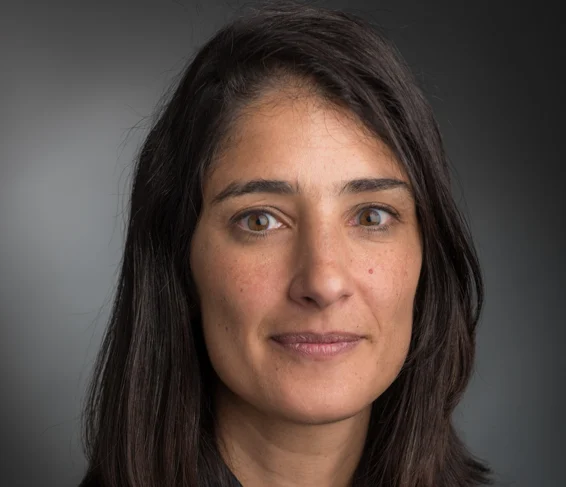https://doi.org/10.55788/e72682f5
Recently, the randomised, phase 2 GeparNuevo trial (NCT02685059) demonstrated that the addition of durvalumab to anthracycline/taxane-based neoadjuvant chemotherapy improved pathologic complete response (pCR) rate and survival in patients with triple-negative breast cancer [1,2]. In a subproject, Dr Hanna Huebner (Erlangen University Hospital, Germany) and colleagues collected blood samples from participants to explore biomarkers that predict who might benefit from neoadjuvant immune checkpoint therapy compared with standard neoadjuvant therapy [3].
At baseline, blood samples from 117 participants enrolled in the GeparNuevo trial were available for RNA testing (n=63 treated with durvalumab/chemotherapy; n=54 treated with placebo/chemotherapy). Based on the RNA expression, 16 different immune cell scores were defined, as well as 26 immune signalling scores. The correlation of these scores with treatment outcome parameters (i.e. pCR, distant disease-free survival [DDFS]) was analysed, as well as any correlation of expression of 31 individual genes with these outcome parameters.
Expression of 1 immune cell score (i.e. mast cells) and 5 individual genes (i.e. CCL3, DPP4, ITGA4, MYC, and TIMP1) were significantly associated with pCR. For example, participants with low CCL3 or high ITGA4 expression benefitted from durvalumab (i.e. higher pCR rate), whereas in participants with high expression of CCL3 or low expression of ITGA4 before neoadjuvant therapy, pCR was lower with durvalumab compared with placebo. On the other hand, high expression of DPP4 or low expression of TIMP1 was associated with a higher pCR regardless of the treatment arm (i.e. durvalumab or placebo added to the neoadjuvant treatment).
With respect to DDFS, 2 immune cell scores, 1 immune signalling score, and the expression of 31 individual genes appeared to be significantly associated with this treatment outcome parameter. For example, a high Treg cell score was associated with a longer DDFS, both for placebo- and durvalumab-treated participants. Participants with low AKT signalling scores benefitted from durvalumab, whereas durvalumab did not improve DDFS in participants with a high AKT signalling score. Likewise, low expression of CDK2, high expression of MYC, and high expression of TIMP1 were associated with a DDFS benefit of durvalumab.
Based on these results, Dr Huebner concluded that “in patients with triple-negative breast cancer, RNA expression levels from peripheral immune cells could enable differentiation between patients who might benefit from neoadjuvant immune checkpoint therapy compared with standard therapy. However, further research is necessary to validate and expand upon these initial results.”
- Loibl S, et al. Ann Oncol. 2019;30:1279–1288.
- Loibl S, et al. Ann Oncol. 2022;33:1149–1158.
- Huebner H, et al. RNA expression levels from peripheral immune cells, a minimal-invasive liquid biopsy source to predict response to therapy, survival and immune-related adverse events in patients with triple negative breast cancer enrolled in the GeparNuevo trial. Abstract 1101, ASCO Annual Meeting 2023, 2–6 June, Chicago, USA.
Copyright ©2023 Medicom Medical Publishers
Posted on
Previous Article
« Adding pembrolizumab to perioperative chemotherapy improves EFS in early-stage NSCLC Next Article
Adjuvant ribociclib improves invasive DFS in early breast cancer »
« Adding pembrolizumab to perioperative chemotherapy improves EFS in early-stage NSCLC Next Article
Adjuvant ribociclib improves invasive DFS in early breast cancer »
Table of Contents: ASCO 2023
Featured articles
Real-world data support new SOC in patients with SCLC
What can real-world evidence teach us about atezolizumab plus bevacizumab in HCC?
Colorectal Cancer
7-year outcomes of PRODIGE 23 trial
Neoadjuvant chemotherapy may be viable option in locally advanced colon cancer
De-escalation of neoadjuvant treatment of locally advanced rectal cancer is non-inferior
Breast Cancer
SONIA: No survival benefit with first-line versus second-line CDK4/6 inhibition in metastatic breast cancer
Adjuvant ribociclib improves invasive DFS in early breast cancer
Gene expression profiles predict benefit of neoadjuvant immune checkpoint therapy in triple-negative breast cancer
Lung Cancer
Adding pembrolizumab to perioperative chemotherapy improves EFS in early-stage NSCLC
TTFields therapy: a new treatment modality for metastatic NSCLC
Adding chemotherapy to EGFR TKI does not improve OS in advanced EGFR-mutated NSCLC
Upper GI Cancer
No improved OS in pancreatic cancer after neoadjuvant mFOLFIRINOX
AI detects gastric cancer with high accuracy in common blood tests
Melanoma
Response-directed treatment personalisation in stage III melanoma
Prognostic and predictive biomarkers in patients with resected stage IIB/C melanoma
GU Cancers
Combining PARP inhibition and androgen receptor-signalling inhibition improves radiographic progression-free survival in HRR-deficient mCRPC
Erdafitinib outperforms chemotherapy in FGFR-altered advanced urothelial cancer
Probiotic CBM588 seems to improve clinical effect cabozantinib/nivolumab in mRCC
Exploratory analysis of IMvigor130 trial finds no OS benefit from atezolizumab in subgroups
Miscellaneous
Immune checkpoint inhibition improves PFS in non-BRCA-mutated ovarian cancer
First-line nivolumab-AVD improves PFS both in adult and paediatric patients with advanced Hodgkin lymphoma
Vorasidenib successfully targets IDH1/2-mutated glioma
ASCO Interviews
IMbrave050: Adjuvant atezolizumab plus bevacizumab provides landmark recurrence-free survival for HCC
What can real-world evidence teach us about atezolizumab plus bevacizumab in HCC?
Related Articles

October 12, 2022
Pro-active management of quality-of-life in breast cancer

© 2024 Medicom Medical Publishers. All rights reserved. Terms and Conditions | Privacy Policy

